Over the past few weeks, we've revealed how to build the healthiest order possible at your local Chinese, Indian and Mexican restaurants—while still enjoying your favourite flavours.
This time, the Daily Mail takes a deep dive into a typical Thai menu to pick out the the most nutrient-dense dishes, and point out the most calorific, and it's bad news for people who love noodles...
The most recent figures estimate there's between 2,000 and 2,500 Thai restaurants in the UK, and it's not uncommon to see Thai-inspired dinner kits and ready meals at the local supermarket.
With its focus on fresh ingredients and rich flavours, it's unsurprisingly becoming a favourite with Britons, with a huge array of regional dishes which appeal to every preference.
'Thai food is a vibrant blend of herbs, spices, and fresh ingredients that makes it one of the more flavourful—and potentially healthier—takeaway options,' says Kerry Beeson, a Nutritional Therapist from meal service Prep Kitchen.
'Many Thai dishes are full of vegetables like vitamin C rich broccoli and green beans, which are stir–fried or grilled quickly—this helps to retain nutrient content so can be a healthy choice when minimal oil is used.
'You'll also find some authentic Thai vegetables like pea aubergines, which are full of fibre, antioxidants, potassium, and magnesium.
'Compared to typical Western fast food, Thai dishes are often lower in saturated fats and made with aromatic herbs like coriander, garlic, and ginger.
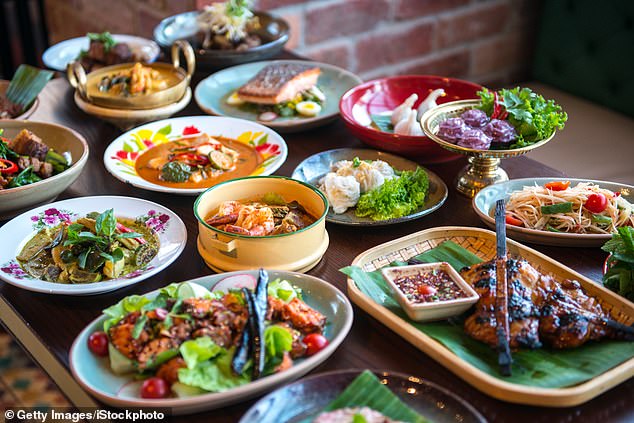
'Garlic is a Thai staple, it is a natural antimicrobial and prebiotic, and great for gut health.
'Thai food is also flavoured with spicy ginger, which helps reduce inflammation and soothe digestion, and the signature spice in Thai food: the chilli pepper.
'Chillies contain capsaicin, which improves circulation and blood flow. They are also a known aphrodisiac!'
The presence of coriander, arguably the most divisive plant on Earth because of how it tastes delicious to some people but 'soapy' to others, also helps to up its healthiness.
Coriander is rich in terpinene, quercetin, and tocopherols, plant compounds with antioxidant and anti–inflammatory benefits.
A major ingredient in Thai cuisine is coconut milk, making many of the creamier dishes suitable for vegans and people with dairy allergies and intolerances.
'It's also rich in medium–chain fatty acids like lauric acid and caprylic acid, which are converted into ketones that the body can use for energy without affecting blood glucose,' says Ms Beeson.
'They also have antimicrobial and anti–inflammatory properties.

'Coconut milk also provides small amounts of minerals such as magnesium, potassium, and iron, supporting immune function and energy metabolism.
'However, despite its health benefits, coconut milk is high in saturated fats and calories, with around 445 calories per cup, so shouldn't be consumed to excess.'
The NHS recommends that adult men consume no more than 30g of fat per day, and women aim for a maximum of 20g.
But coconut milk isn't the only element which it pays to be mindful of, according to Ms Beeson.
Many Thai dishes use refined white rice or noodles, which are low in fibre and can spike blood sugar levels.
'Swapping white rice for cauliflower rice or brown rice, which are options in some restaurants, can significantly increase fibre intake and lower the glycemic impact,' she says.
Dishes deep–fried at high temperatures may degrade oil quality and the nutritional value of the food, and heavy, rich sauces can be full of fat and sugars.
'Thai ingredients are very bold and may not suit everyone,' she says.
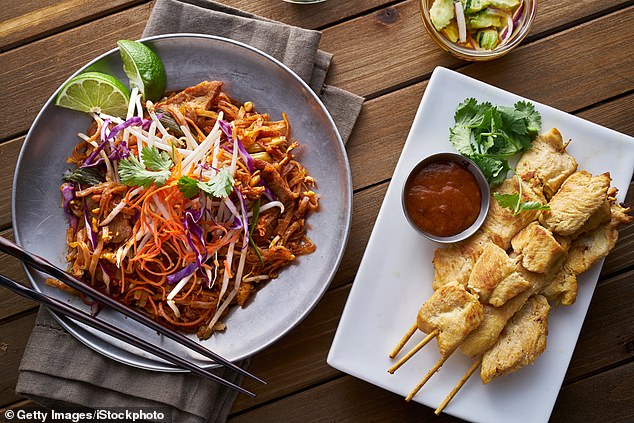
The capsaicin in chillies can cause indigestion or be a trigger for heartburn in some people. Chillies can also cause stomach cramps and diarrhoea.
'Furthermore, the strongly flavoured dishes can be very high in sodium from seasonings such as soy and fish sauce.'
NHS guidelines advise adults eat no more than 6g of salt per day, which is roughly a teaspoon. Excess salt has been linked to high blood pressure and deadly heart disease.
Similarly, health chiefs advise men eat no more than 2,500 calories per day and women 2,000 calories.
If you choose wisely, however, Thai food can be one of the healthier forms of takeaway or restaurant meal.
'Thai is a very innovative cuisine, and you may find each restaurant has its own specials in addition to the classics,' says Ms Beeson.
'As many of the dishes are cooked fresh to order, it can be possible to ask for the dishes to be tailored to your needs.'
With that in mind, Ms Beeson shares the five healthiest dishes on a typical Thai menu... and five which should be enjoyed only as an occasional treat.
Som tam (green papaya salad)
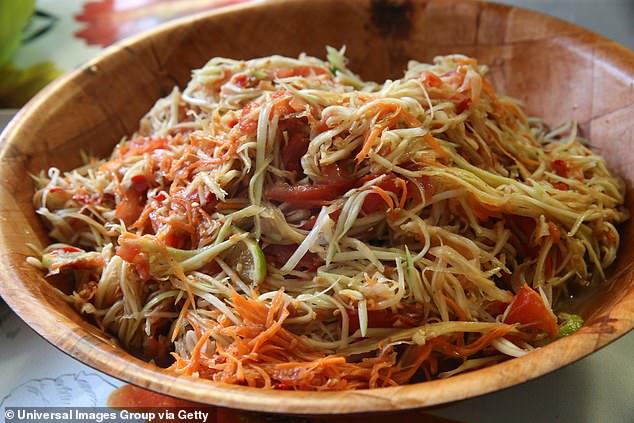
The most famous Thai salad, it is named after its preparation method; 'som' means sour, and 'tam' represents how the ingredient are pounded together in a mortar and pestle to release and blend the flavours.
Ms Beeson said: 'Thai salads are typically full of crunchy, raw or lightly cooked fruits and vegetables, making them low in fat and calories and high in antioxidants, and vitamin C.
'Opt for versions which contain more veg and not less healthy ingredients like glass noodles.'
A typical portion of 220g has just 111 calories, and less than a gram of salt.
However, it can be high in sugar, with a portion packing 15g, half of the NHS' daily recommendation of 30g.
Tom yum goong soup (prawn)
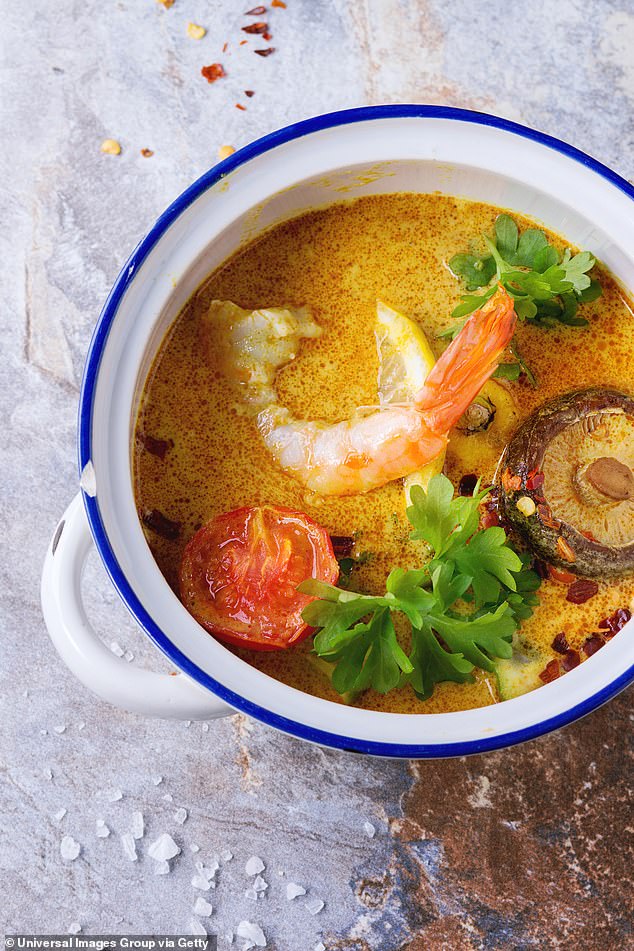
It's soup season in the UK, but you don't need to stick with a trusty tin of tomato, you can choose a Thai classic, tom yum.
This dish is packed full of flavour but usually has just 50 calories per 240g serving, and only 2g of sugar, according to Ms Beeson.
She says: 'A hot and sour broth packed with prawn, chili, lemongrass, and galangal (a root similar to ginger), and it's also usually available with chicken or tofu as the protein option.
'It can be high in sodium, but is naturally low in fat and calories, and as it usually contains lots of herbs, veg and spices supplies vitamins, fibre, antimicrobial plant compounds, and antioxidants.'
Stir–fried vegetables
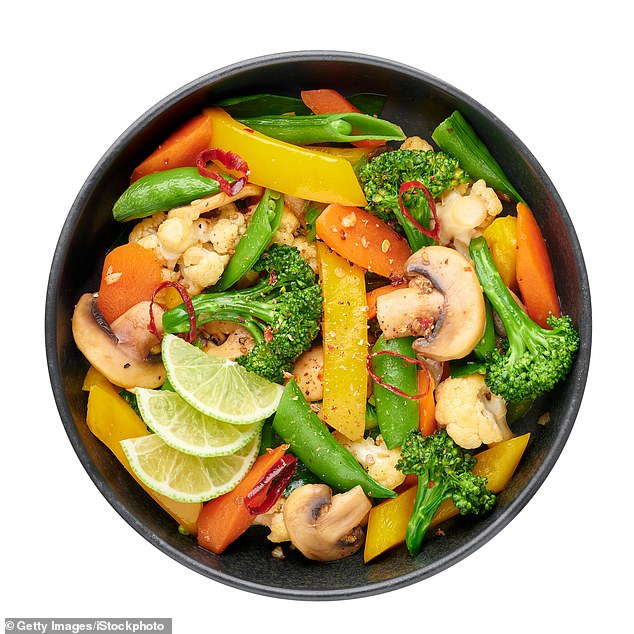
For years it's been drummed into us that we should be eating five 80g portions of fruits and vegetables every day, making this dish a no-brainer.
Ms Beeson estimates that, depending on the type of vegetables and the oil used, there are around 200 calories per 240g serving.
The dish is at its healthiest when it comes stir–fried with lots of fresh herbs and spices, and has minimal added oil and salt.
'This dish typically provides a good source of dietary fibre, vitamin C, and antioxidants,' she says.
'You can usually have this dish served with your choice of lean protein as a main meal, and most restaurants will remove soy sauce or fish sauce and season with a little salt and pepper to reduce the sodium content.'
Grilled chicken (gai yang)
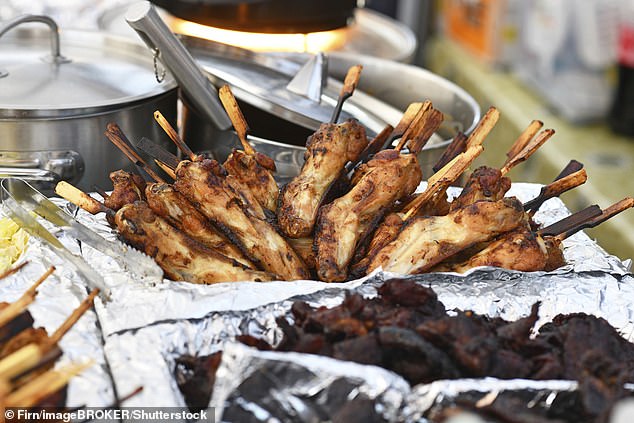
There's around 230 calories in each 100g portion of grilled chicken, with the choice of marinade adding between 4–12g of fat to your plate.
'Thai grilled meat or prawns are usually marinated with garlic, coriander, and lemongrass, and offer a lighter choice that is high in lean protein and B vitamins, and lower in fat, carbs and calories,' says Ms Beeson.
Adding a portion (around two tablespoons) of peanut-based satay sauce can easily add on an extra 100 calories, so be mindful if you're watching your waistline.
Steamed fish

Steamed fish is a light main dish which usually consists of sea bass, marinated in ginger, lime juice, garlic, and chillies.
Ms Beeson estimates that there are around 130 calories per 100g fillet, depending on the marinade, and no more than 7g of fat.
'It's high in lean protein, low in fat, and a good source of magnesium, phosphorus, vitamin B12, and selenium. This is one of the healthier choices on a Thai menu,' she says.
The NHS recommends that we eat two portions of fish a week. Research has also suggested that increasing our fish consumption could reduce the risk of type 2 diabetes and certain cancers.
We've seen the healthiest dishes on the menu, but what about the ones which should only be an occasional treat?
Pad Thai (chicken)

Pad Thai is arguably the most famous Thai dish, but with around 800 calories, 20g of sugar and 45g of fat per serving, it should be enjoyed in moderation.
The dish is made from stir fried rice noodles, egg, peanuts, palm sugar, and fish sauce, with a handful of colourful veg and a protein like chicken, tofu or prawn.
Ms Beeson explains: 'Though it's a beloved staple, Pad Thai is a dish that's often stir–fried in oil and loaded with sugar, soy sauce, and refined white rice noodles.
'Large sharing portion sizes make it energy–dense and easy to over–consume.'
Massaman curry with chicken
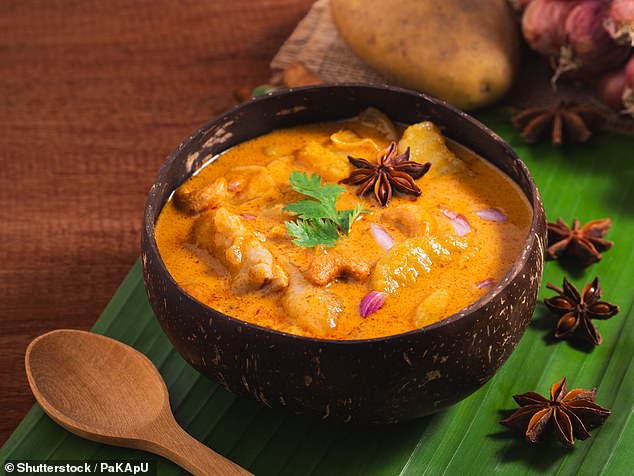
Vibrant curries are a staple of any Thai menu, but one in particular should be enjoyed in moderation.
Ms Beeson estimates that a typical serving of a massaman curry, which is made with a dense combination of coconut cream, potatoes, and peanuts, can have 540 calories per serving, and 20g of fat.
'Whilst it's full of Thai flavours, it's one of the most calorific Thai curries due to its high fat and carb content, and often lowest in vegetables,' she says.
'It's usually served with white rice, which can significantly increase the calorie content (by about 200 calories) and offers little in the way of nutritional value.'
Thai fried rice (khao pad)
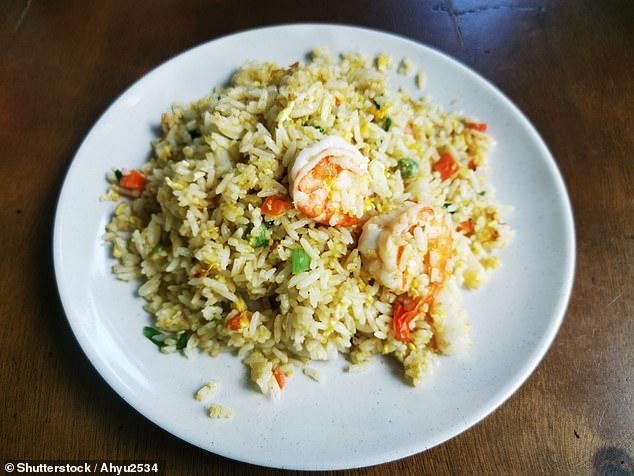
With a base of white rice, khao pad has 320 calories per serving, and up to 20g of fat—two-thirds of a man's recommended daily allowance—this dish should be an occasional treat.
'Made with white rice and cooking oil, this dish is low in fibre and nutrients, and high in fat and calories,' says Ms Beeson.
'It often includes added sauces and high–sodium seasonings, and few vegetables.'
Fried Vegetable Spring Rolls

A popular side or starter, these golden parcels of vegetable ribbons can easily add 440 calories to your meal, and 19g of fat.
Ms Beeson says: 'Don't be deceived by the lure of vegetables in the name, these Thai treats are deep–fried and served with sugary sweet dipping sauces.
'They are high fat and offer little nutritional benefit beyond starch and oil, due to the cooking at high temperatures.'
Mango Sticky Rice
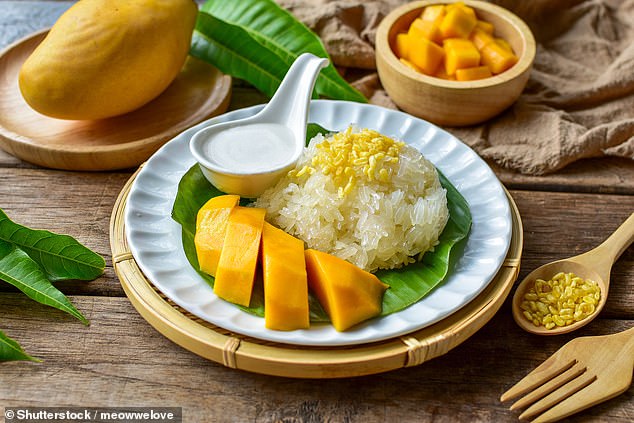
There can be close to 500 calories and 25g of fat in a portion of mango rice, a classic Thai dessert made with coconut cream, rice and juicy, golden mango.
The combination, according to Ms Beeson, means there is a whopping 42g of sugar per serving.
She says: This simple dessert is a favourite on Thai menus, but whilst it's delicious and offers a few antioxidants in the mango, this combination of sweet sticky rice with coconut cream and ripe mango is high in refined carbs and sugar, and low in fibre, protein, and other nutrients.'
Read more- Is your favorite Chinese takeaway dish secretly a high-calorie, sodium bomb that puts your heart and body at risk?
- Could your beloved Indian takeaway actually be one of the healthiest options around, thanks to vibrant spices, fresh vegetables, and lean proteins?
- Craving a classic roast dinner? Discover why this Brit believes Thailand serves up English dishes better than the UK itself!
- Is your favorite Mexican dish a nutritional powerhouse or calorie bomb? Discover which dishes nutritionist Lily Soutter warns you to enjoy in moderation!
- Could this tropical Thai delight be the most heavenly dessert ever discovered, or is it simply too sweet to handle?



%20(1024%20x%201024%20piksel)%20(5).png)
%20(1024%20x%201024%20piksel)%20(1).png)
0 Comments